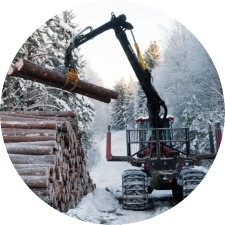Rationale
To maintain and strengthen the competitiveness of the European forest-based sector it is crucial to secure efficient, sustainable and high quality raw material supply. The provision of raw materials and the further development of efficient and environmentally-friendly forest operations, transport systems and management models for biomass supply chains are core activities of the forest-based sector.
State of the Art 2012
The EU’s growing stock is increasing. In 2010 the annual increment of Europe’s forests was 768 million m3, while the annual harvest was 484 million m3, equivalent to 63 % of the increment. Though variation is large, in no EU country does the harvest exceed increment. Still, the supply of biomass is far from secure. Reasons for this vary and include the divergent interests and stakes between industries and forest owners, probably due to a large variation in ownership categories and structure, as well as market mechanisms and the efficiency in forest operations, which differ substantially between regions. New techniques now permit the measurement of a number of key wood quality parameters already in the forest. So far these methods have been sparsely implemented.
Expected achievements by 2020
In 2020 a new generation of resource inventory systems and flexible planning tools, enabling precise information on quantity and quality on local, regional and global scales, has evolved. New forest management and wood supply systems have improved the integration along value chains from forest to end-product, shortening lead times, increasing capital turnover, improving profitability of forest ownership and reducing environmental impacts. New, partly autonomous harvesting systems increase productivity in harvesting operations and improve the working environment for operators. The consequences of changing ownership structures for wood supply are better understood and this knowledge is used to advise on policy, reducing the negative impacts of these changes.
Required Research and Innovation Activities
A. Develop new inventory techniques for determining quantity, quality, dimensions and specific properties of forest resources.
B. Assess the future availability of woody biomass for different uses.
C. Develop flexible planning and decision support tools for obtaining sustainable wood supply from multipurpose forest landscapes.
D. Provide new and cost-efficient techniques to allow for chain of custody assessment.
E. Develop intelligent forest operation systems and new solutions for human-machine-terrain interactions.
F. Develop new (or adapt existing) ICT solutions for new, smart and integrated transport and logistics systems from local and regional to global scale.
G. Develop decision support systems for optimised supply chain management, including cascade use of wood, fibres and biomass, linked to forest planning tools for multifunctional forest management.
H. Assess market mechanisms, organisational systems and organisational behaviour to improve supply chain management systems.
I. Develop innovative processing concepts to be carried out during transport



